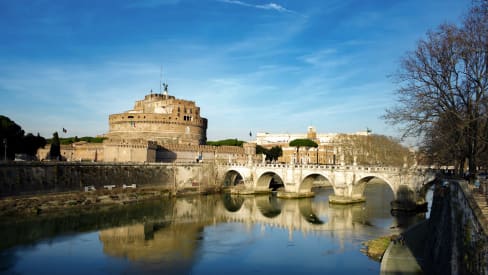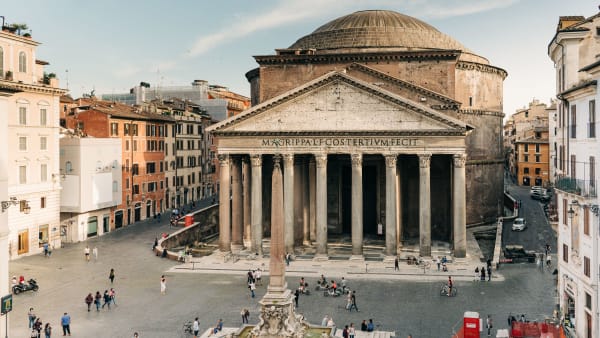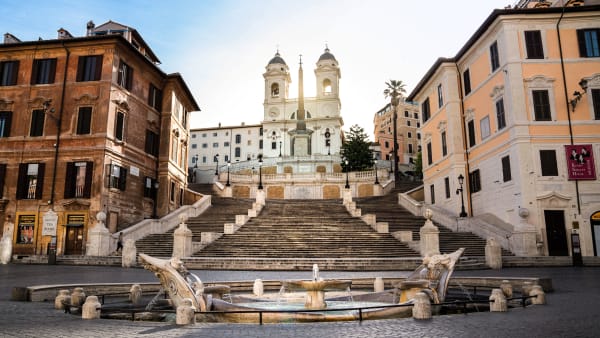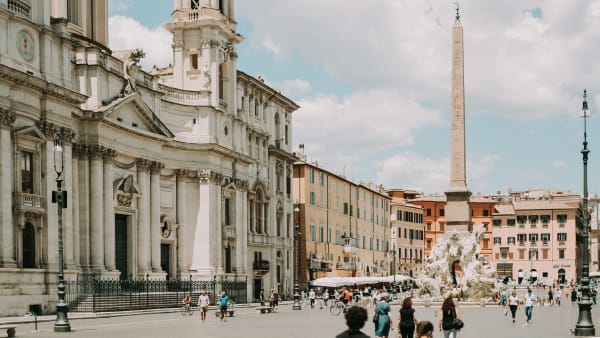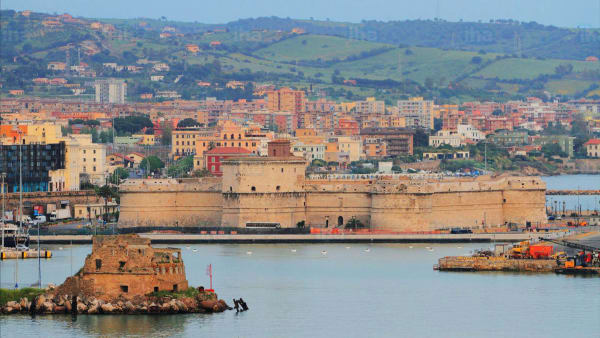Curiosities
Curiosities
Castel Sant’Angelo has inspired many personalities, filmmakers, and songwriters throughout history. For example, did you know that the castle appears in the blockbuster Angels and Demons? And that the rooftop terrace plays an important role in the third act of Puccini’s famous opera Tosca? Keep reading to discover more curiosities!
The origin of the name
As mentioned in the historical section of this article, the monument was originally a mausoleum. In 403 AD, when it became a fortress for defense purposes, it was given the name Castello.
Another variation of the name arose around 590. At that time, Pope Gregory I organized a solemn, ecclesiastical procession to beg God to end the plague epidemic. It seems that as he crossed the Pons Aelius, he received a vision of the archangel Michael sliding his sword back into its sheath.
The pope interpreted this as the end of the plague, which ended shortly thereafter. Therefore, in honor of the archangel, the pope had a statue erected that looked out over the city, on the spot where Michael appeared.
The statue of the archangel
The statue that can be seen there today is not the original one. The first version was made of wood, but it crumbled due to the weather and was replaced by a marble statue that was destroyed during a siege in 1379.
It was then replaced by a new marble angel, which was struck by lightning in 1497. The fourth, made of bronze and covered with gold, was melted down to make cannons.
Finally, another bronze statue was chiseled in 1573, which remained on the highest part of the castle for more than two hundred years. Because it was badly damaged, it was removed in 1747 and replaced in 1752 by the present bronze statue by Peter Anton van Verschaffelt, which attracts the attention of thousands of visitors each year.
The macabre prisons
As mentioned before, the castle was used as a political prison in the 19th century. Apart from the courtyard where the prisoners were executed, there were numerous rooms used as prisons that can still be visited today.
The worst prison cell in the castle was the Sammalò or San Marocco, at the rear of the Bastione San Marco. The prisoner was lowered from above and had no room to stand or lie down. The cell used to be one of the four vents of Hadrian’s Mausoleum.
On the first floor of the building, cells were reserved for important people, such as the sculptor Cellini. To the right of the Loggia of Paul III are eleven cells for political captives.
Famous prisoners included the humanists Platina and Pomponio Leto, Beatrice Cenci (who was sentenced to death despite her young age), Giordano Bruno, as well as Italian patriots during the Risorgimento.
The famous escape of Benvenuto Cellini
As mentioned in the previous paragraph, the sculptor was one of the castle’s most famous prisoners for almost a year. It seems that he was locked up in the last cell south of the upper Courtyard of Alexander VI.
On the night of Corpus Christi 1538, he decided to tie several sheets together to make a long rope with which he lowered himself right through the latrine (to the right of the cell) and managed to escape.
After he was re-arrested, he was held captive in the cell that was an extension of the large well, which can still be found under the floor of the courtyard. It seems that Cellini complained not only about the darkness, the tarantulas, and the poisonous worms, but also about the fact that there was so much water.
On one wall of the cell is a glass pane shielding a (now not so recognizable) drawing. For his comfort during his imprisonment, the artist had sketched a picture of God with a risen Christ.
The controversial decoration of the papal residence
As mentioned in the section on the Room of Cupid and Psyche, the decorations in the bedroom of Paul III Farnese (1534-1549) were based on the fairy tale of Apuleius in the novel “The Golden Donkey.” Here’s the story in brief.
Once upon a time, there was a young woman named Psyche, who was so beautiful that at one point she was worshipped even more than Venus. The Roman goddess of love became furious and decided to send her son Cupid to match her with the most horrible man he could find. However, the plan didn’t succeed because, in the end, he became her husband. The only drawback was that she was never allowed to see Cupid and therefore he only came to see her at night.
After Psyche became pregnant, she decided one day to hide an oil lamp under the bed to secretly unmask her lover. That night, when Cupid accidentally woke up when Psyche looked at his face, he had to flee. After all, he had disobeyed his mother’s command. However, after the young woman had passed the severe tests of the gods, Jupiter gave her a potion that made her immortal, just like her husband. Thus they lived happily ever after.
The reason why the decorations of the papal room are connected with this story is that it contains a Christian moral. Psyche is considered the personification of the soul (Psyché in Greek means “soul”) and the trials she underwent represent a difficult but necessary path to finally be rewarded with eternal salvation. The frieze of the room depicts the trials on which Psyche makes every effort to be forgiven by the gods.
The expression “Mastro Titta crosses the bridge”
This is a famous phrase used by the citizens when they saw the executioner of the Papal State (known as Mastro Titta) crossing the bridge in the direction of the Castle, knowing that a man would lose his life soon.
His career as an executioner of death sentences began in the late 18th century when he was only 17 years old. In 68 years of service, Mastro Titta tortured and executed 516 people. The bloody and macabre executions were carried out in various ways (e.g. using a gallows or guillotine) in the courtyard which was perfectly legal at the time.
The executioner lived in Borgo (near the castle) and earned his living as an umbrella-maker. Since he was known for his gruesome side job in Castel Sant’Angelo, he was asked to cross the bridge to the castle only when necessary.
Ponte Sant’Angelo and its ten angels
The St. Angelo Bridge connects the Piazza di Ponte Sant’Angelo with Castel Sant’Angelo. The bridge was built in 134 by Emperor Hadrian but wasn’t named Ponte Sant’Angelo until around the 16th century.
At the beginning of the bridge, on the bank opposite the castle, are the statues of Saint Peter and Saint Paul. The former holds the keys to heaven and the latter a sword. The ten angels on the rest of the bridge show the objects of Christ’s suffering: the crown of thorns, the cross, whips, nails, etc.
On the bridge where Bernini’s statues now stand, the severed heads and corpses of those condemned to death used to be displayed for deterrence.
The influence on pop culture
As mentioned earlier, the multi-faceted building hasn’t only meant a lot in the past but also had a great influence on contemporary pop culture.
The famous roof terrace, for example, is the point from where the namesake leaps to her death in the third act of Puccini’s famous opera Tosca.
As mentioned before, the Castle also makes an appearance in the movie Angels and Demons and has been used as inspiration in video games such as Assassin’s Creed II, with a starring role in Assassin’s Creed: Brotherhood.


